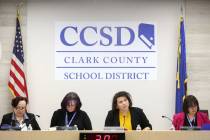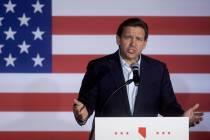EDITORIAL: Fight for funding flexibility, not class-size reduction
Say this for advocates of class-size reduction. Decades of failure haven’t dampened their faith.
Now, they’re hoping pandemic-induced changes will show this bottomless pit needs even more financial support.
The coronavirus has certainly disrupted education over the past year. Some students around the country and even Nevada returned to the classroom, at least part time, last fall. Not in the Clark County School District. The Board of Trustees didn’t permit in-person instruction until March, aside from a few rural schools.
That’s when pre-K through third grade students were allowed to return for hybrid instruction, if desired. The kids who did return to campus attended class only twice a week with three days of online instruction.
As a consequence, when students were learning in person, the classes were much smaller than usual. That changed Tuesday, when elementary schools reopened for all students for five-day-a-week in-person instruction.
This experiment was likely too short to draw firm conclusions about the academic merits of smaller classes. There are also many complicating factors, such as a year of online instruction and the hybrid program itself.
But there’s no need to rely on such a small sample to draw conclusions about Nevada’s class-size reduction experiment. The state has been funding this initiative in the lower grades for more than 30 years, spending more than $3 billion. Continued poor test scores — and the supposed need for more money — provide ample evidence that the program hasn’t delivered.
That hasn’t reduced its appeal. Teachers unions love it because it increases their membership rolls. Parents love it because every mom and dad wants their child to receive individualized attention. And, in some cases, complaints about unworkable class sizes are justified. Fifty kids in a high school math class doesn’t do anybody any good.
But for a $3 billion investment, Nevada deserves more than warm feelings. In fact, class-size reduction has produced little in the name of tangible results. Yet its advocates continue to insist that the problem resides with Nevada’s stingy taxpayers. They ignore recent history. Twice over the past two decades, Nevada’s elected officials have passed — at the time — the largest tax increase in state history, specifically to fund education.
That last happened in 2015. Politicians directed much of the new money to literacy training and programs that allowed individual schools to offer a range of additional programs.
That’s a good model to follow. Education advocates should push for more school-specific flexibility with current funding, not more use-restricted funds for class-size reduction.






















